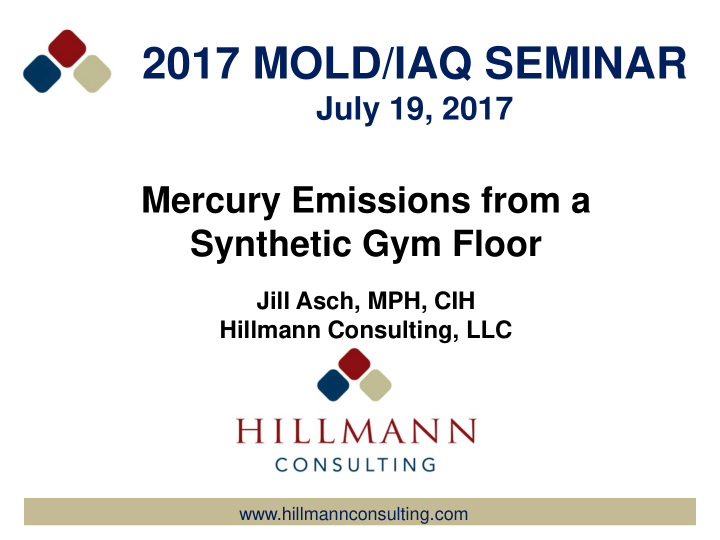



2017 MOLD/IAQ SEMINAR July 19, 2017 Mercury Emissions from a Synthetic Gym Floor Jill Asch, MPH, CIH Hillmann Consulting, LLC www.hillmannconsulting.com
Mercury Containing Synthetic Floors • Resilient, rubber-like • Gyms, tracks (mostly) • 1960’s to the mid-1980’s • Many 3M “Tartan” brand • Release elemental mercury – Health effects • Students • Physical education teachers www.hillmannconsulting.com
Assessments • Determine if gym floor is rubber-like • If so, air monitoring can determine if there are exposures to mercury – Direct Read Instrumentation • Confirmation that flooring contains mercury – Sampling of floor cores – Greater than 1 ppm www.hillmannconsulting.com
Considerations for monitoring • Hot days in gyms • Poor ventilation • Cleaning of gym floors with abrasive cleaners • Damage to flooring • Fire damage • Planned removal www.hillmannconsulting.com
www.hillmannconsulting.com
Levels elevated? New Jersey Education Association (NJEA), New Jersey Environment Council (WEC), and Healthy Schools Now (HSN) Coalition suggested exceedance level: • 60 nanograms of mercury vapor per cubic meter of air (ng/m3) • Provide ventilation to reduce exposure www.hillmannconsulting.com
Still elevated? • Removal necessary – Containment of removal area – Entrances sealed – HVAC-systems isolated and shut-down – Negative pressure exhaust systems – Segregated work zones – Pedestrian access restricted – Costs for removal can be significant www.hillmannconsulting.com
Need help? • Complete questionnaire • Hillmann employee will contact you to provide: – Direct Read air monitoring for mercury – Sampling of gym floor, if requested – Air monitoring during floor removal www.hillmannconsulting.com
www.hillmannconsulting.com
Recommend
More recommend